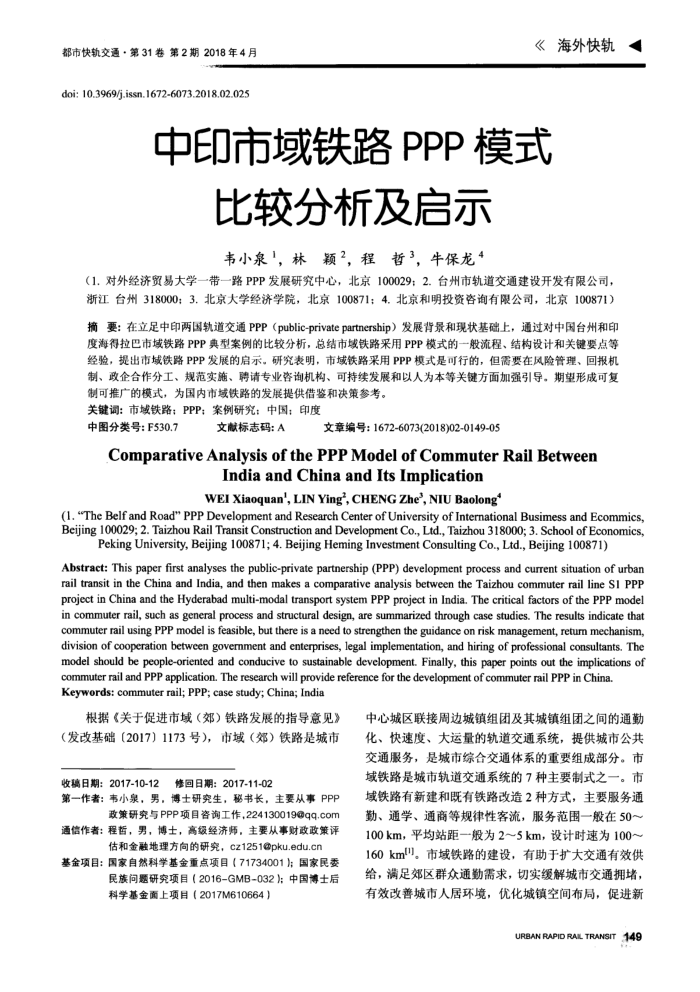您当前的位置:首页>论文资料>中印市域铁路PPP模式比较分析及启示
内容简介
 都市快轨交通·第31卷第2期2018年4月 doi: 10.3969/j.issn.1672-6073.2018.02.025
都市快轨交通·第31卷第2期2018年4月 doi: 10.3969/j.issn.1672-6073.2018.02.025《海外快轨
中印市域铁路PPP模式
比较分析及启示韦小泉,林颖2,程哲3,牛保龙4
(1.对外经济贸易大学一带一路PPP发展研究中心,北京100029:2.台州市轨道交通建设开发有限公司,浙江台州318000:3.北京大学经济学院,北京100871;4.北京和明投资咨询有限公司,北京100871)
摘要:在立足中印两国轨道交通PPP(public-privatepartnership)发展背景和现状基础上,通过对中国台州和印度海得拉巴市域铁路PPP典型案例的比较分析,总结市域铁路采用PPP模式的一般流程、结构设计和关键要点等经验,提出市域铁路PPP发展的启示。研究表明,市域铁路采用PPP模式是可行的,但需要在风险管理、回报机制、政企合作分工、规范实施、聘请专业咨询机构、可持续发展和以人为本等关健方面加强引导。期望形成可复
制可推广的模式,为国内市域铁路的发展提供借鉴和决策参考。关键调:市域铁路;PPP;案例研究:中国:印度
中图分类号:F530.7
文献标志码:A
文章编号:1672-6073(2018)02-0149-05
ComparativeAnalysis ofthePPPModelof CommuterRailBetween
Indiaand China andItsImplication WEI Xiaoquan', LIN Ying', CHENG Zhe', NIU Baolong
(1. “The Belf and Road" PPP Development and Research Center of University of International Busimess and Ecommics: Beijing 100029; 2. Taizhou Rail Transit Construction and Development Co., Ltd., Taizhou 318000; 3. School of Economics,
Peking University, Beijing 100871; 4. Beijing Heming Investment Consulting Co., Ltd., Beijing 100871)
Abstract: This paper first analyses the public-private partnership (PPP) development process and current situation of urban rail transit in the China and India, and then makes a comparative analysis between the Taizhou commuter rail line S1 PPP project in China and the Hyderabad multi-modal transport system PPP project in India. The critical factors of the PPP model in commuter rail, such as general process and structural design, are summarized through case studies. The results indicate that commuter rail using PPP model is feasible, but there is a need to strengthen the guidance on risk management, retum mechanism, division of cooperation between government and enterprises, legal implementation, and hiring of professional consultants. The model should be people-oriented and conducive to sustainable development. Finally, this paper points out the implications of
commuter rail and PPP application. The research will provide reference for the development of commuter rail PPP in China. Keywords: commuter rail; PPP; case study; China; India
根据《关于促进市域(郊)铁路发展的指导意见》(发改基础(2017)1173号),市域(郊)铁路是城市收稿日期:2017-10-12修回日期:2017-11-02
第一作者:韦小泉,男,博士研究生,秘书长,主要从事PPP
政策研究与PPP项目咨询工作,224130019@qq.com
通信作者:程暂,男,博士,高级经济师,主要从事财政政策评
估和金融地理方向的研究,cz1251@pku.edu.cn
基金项目:国家自然科学基金重点项目(71734001);国家民委
民族问题研究项目(2016-GMB-032);中国博士后科学基金面上项目(2017M610664)
中心城区联接周边城镇组团及其城镇组团之间的通勤化、快速度、大运量的轨道交通系统,提供城市公共交通服务,是城市综合交通体系的重要组成部分。市域铁路是城市轨道交通系统的7种主要制式之一。市域铁路有新建和既有铁路改造2种方式,主要服务通勤、通学、通商等规律性客流,服务范围一般在50~ 100km,平均站距一般为2~5km,设计时速为100~ 160kml"]。市域铁路的建设,有助于扩大交通有效供给,满足郊区群众通勤需求,切实缓解城市交通拥堵,有效改善城市人居环境,优化城镇空间布局,促进新
URBAN RAPID RAIL TRANSIT 149
上一章:高速铁路路桥过渡段动力响应研究
下一章:轨道交通与快速路共路由敷设方案的一体化研究